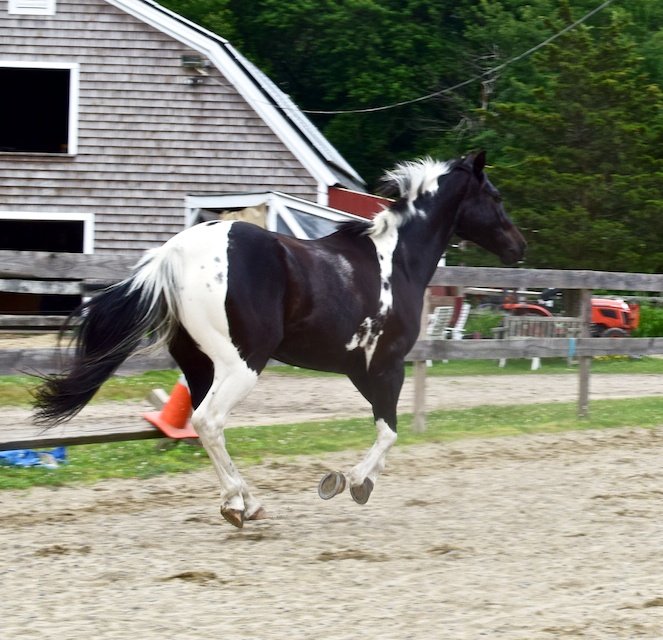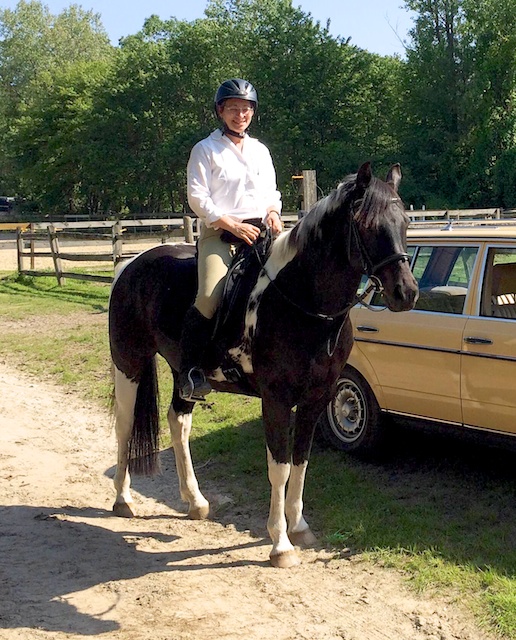Although you don’t see him on the cams, Tonka is as much a part of my life as the animals that you watch here at HenCam. In fact, I spend more time with him that anyone else in the family. My sons (one home from college, one in high school) assume that if they don’t see me around the house, that “mom’s at the barn.”
There’s all sorts of theories about why women love horses. I’ve heard people go on and on about how women get a power rush from being able to control a large beast, and that there’s an undercurrent of sexual connotations. I don’t buy it. It’s also not just about having an animal to talk to – for that people have dogs. I became smitten with horses as a toddler and that love has never ebbed. I’ve put a lot of thought into why that is.
Horse are domestic animals. They’ve been working alongside people for thousands of years. They relate to us. They communicate with us. That’s true of other domestic animals, from dogs to chickens, but, with horses it’s at another level. Because we ride them, we can communicate instantaneously through our bodies. So, for example, not only do I know what Tonka is looking at because I can see his head turn, and his ears flick, but I can feel it, too. Conversely, that goes for him as well. He knows where I’m looking. He feels if I’m tense. If I shift my weight from one hip bone to the other, he senses it, and, with training, will adjust what he does accordingly. Ride with enough quiet and tact, and you feel each other breathe. Go out into the world on your horse, and you see the landscape together. You can’t do that with any other animal.
There’s this theory out there about how, because horses are prey animals, (big carnivores want to eat them) that they relate to humans as if we are predators and are a threat to them. “Natural horsemanship” bases a lot of their training on this premise. I think it’s totally wrong. Horses are smart enough to know that we’re not going to hunt them. We might scare them once in awhile (and they might scare us) but it’s not a predator/prey relationship. My horse knows I’m not a mountain lion. If I trained him as if I were, I’d be causing a lot of problems between us. There’s also this idea that, because horses are herd animals, and that the herd has a hierarchy, that we humans have to take the dominant position in the group. I don’t agree with that, either. First of all, horses know that we’re not horses. They don’t expect us to be part of their herd. Secondly, there’s a lot of misunderstanding with what “dominance,” and “leadership” is. Just thinking that you have to be “dominant” makes you behave in a way that sets up conflict. That doesn’t mean that I don’t maintain a relationship that asks for and requires appropriate and safe behavior from my horse; it does meant that I don’t rely on aversive training techniques to have that relationship. Horses are social animals and develop long-lasting and deep friendships over time. That’s the key. That’s what I aim for.
On the other hand, even though I don’t have to act like a horse to train Tonka, it does help, in our relationship, to be aware of what horses respond to. They’re hyperaware of movement, and so being calm and predictable is something that I try to do. They respond to body language and so I am aware of where I place myself in relation to my horse. They vocalize rarely, but when they do, it means something, and so I try not to chatter, but I do use my voice, when I have something to say.
The relationship with my horse fascinates me and enriches my life. But there’s something else about horses. Beauty. Especially in movement.
Of the three horse gaits, walk, trot and canter, two of them have moments when all four feet are off of the ground.
Here is Tonka at the trot.
This is the canter.
How amazing is it that I can put a saddle and bridle on this horse, and he’ll do that when I’m on his back? That I can take flight with him?
That said, it’s not the rush of galloping that makes me so happy around horses. We can be standing still, like we are in the photo below. Actually, look closely at it. We’re not still at all. Tonka has one ear towards the camera, and one ear back to listen to me. My legs are on his sides and I can feel that he’s relaxed, but also ready to move off. He’s waiting for me to tell him what’s next.
And so the conversation continues. What’s next, Tonka?




Beautiful, just beautiful, the story and the pictures! I will have to show this to my daughter, the horse lover. She had a thoroughbred in her single life but after marriage and a daughter she’s without. Maybe again some day.
Does he have shoes on now?
Yes, the paddocks and trails are too rocky. Tonka never went lame, but he was going carefully. He’s moving more confidently now.
Good for him…..I don’t like going barefoot either.
Back in the beginning before I began training horses, I spent most of my time riding bareback. I learned from feel how they balance us and adjust every stride according to what we’re doing up there. If someone was riding double with me, I could tell what direction they were looking in by how the horse felt under me. It made me realize just exactly how every movement on their back counted, even turning your head.
One mare I rode for a couple of years liked ‘showing’ me things while on the trail. If I wasn’t looking where she was looking, she would do a soft snort. If I still didn’t pay attention, she would reach around and bump my toe with her nose and then look pointedly at what she wanted my attention on. Everything from squabbling birds to critters to, “Hey! Can I go eat those blackberries? PPllleeeaaasse….?”. (Well, yes, she was spoiled just a bit, why do you ask? :D ). I miss her.
Very sweet. I’m sure that you do miss her.
thanks, teri and people who have posted for your thoughts on horses.
i’ve never really known a horse – my first thought when near one is always concern for my toes – it does seem they could step harder on a human foot than any other animal –
and then i guess my next thought would be ‘are you happy?’
i never imagined that if i knew the horse and the horse knew me he could pick up on that!
this is deep!!
thank you, folks!
I know horses, and I have to say that I’m always worried about my toes :)
He is a beautiful paint, that’s for sure. My mini has very similar markings! Her name is Lacey and she got that name because of what appears to be a smattering of lace in the wither down to the belly area, same as Tonka!
Sounds very cute!
Thanks Terry for these great Photo’s! Tonka looks like he is standing firm in his new shoes but very relaxed. I think you make a great looking pair. He’s just the right size for you and he has made the change in living so very easy because of your kind but firm attitude towards him. I love seeing his photo’s. I so miss farming. The animals were my friends. I do have sheep on someone else’s farm but they are mostly for the wool and my sheep to shawl weaving.
I’m glad that you can get some of that farm animal time by watching mine :)
GREAT post, Terry. I just love the thought that you put into your interactions with animals. I know you must do the same with people, who can be far more trying and harder to understand than animals! I “sit” for two horses, now and then, and have your words in mind when I interact with them. Thanks so much!!
Enjoy your horse time!
What beautiful photos of a beautiful horse. I love the ones with all four feet off the ground, truly amazing.
I just got in from having a “conversation” with my horse, Cody. I rode bareback for a while, just walking around the pasture and the back of our property. I love riding bareback and feeling everything he is thinking. My daughter loves bareback riding so much she only saddles when we compete in gymkhanas! It’s amazing to see her balance when we ride our favorite trails by our nearby lake – some of them quite steep! It has definitely helped our saddled riding, especially when zooming around barrels or poles!!!
Lucky you to have places to ride bareback and the right horses to do it with. I tried riding Tonka bareback once. He has prominent withers. Not a comfy ride! :)